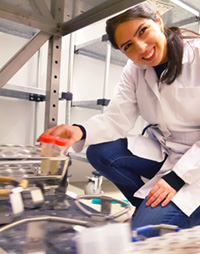By J. Andrew N. Alexander, Graduate Student in Strynadka Lab
Platelet transfusions are an important part of a well-functioning healthcare system, such as the one we are accustomed to in Canada. Specifically, platelet transfusions can be crucial in situations involving massive blood loss or where the body is unable to produce adequate numbers of platelets. Thrombocytopenia, or low platelet levels, can arise in response to trauma, major infections, or following chemotherapy, necessitating a platelet transfusion.
All blood transfusions carry a small risk of infection to the recipient which can be especially problematic in those who are immunocompromised. Making blood transfusions as safe as possible is therefore an active area of research.
- Despite standardization of collection and manufacturing procedures, as well as rigorous product testing, the risk of bacterial contamination in platelet products has not been eliminated and continues to challenge the safety of the blood supply and post-transfusion patient outcomes.
Sometimes, when only a few bacteria are present in solution, tests can give negative results. Tests for bacterial contamination are further complicated by the fact that some bacterial species can form biofilms, a layer of bacteria that strongly adheres to surfaces instead of remaining in solution. When bacteria are not in solution they can be hard to detect in platelet samples. Detecting bacteria that can form biofilms is especially important as these bacteria are often more virulent and can be much harder for the immune system and antibiotics to eliminate.

Narges Hadjesfandiari
Narges Hadjesfandiari and colleagues in the Brooks and Devine labs in the CBR were interested in determining whether the internal surfaces of the plasma bags used for storage could influence bacterial biofilm formation. Some plasma bag producers make the top and bottom panels with a rough interior surface while others make one inside panel smooth and the other rough.
Recently published in Transfusion, Narges discovered that S. epidermidis bacteria, the most common cause of hospital infections, adhere less to smooth platelet bags compared to rough ones. While both interior surfaces of the plasma bag cannot be smooth as this can cause them to adhere to each other during production, this research shows that there are distinct benefits to be gained by making the bottom, inner surface of the bag smooth.
Storing the plasma bags smooth side down makes it harder for bacteria that are in solution to attach and form a biofilm once they fall to the bottom of the plasma bag. Hence, improvements in pathogen detection can be achieved by changing the surface texture of the bottom platelet bag wall.
This relatively easy modification in platelet bag storage has the potential to significantly improve transfusion safety and positively impact public health.


